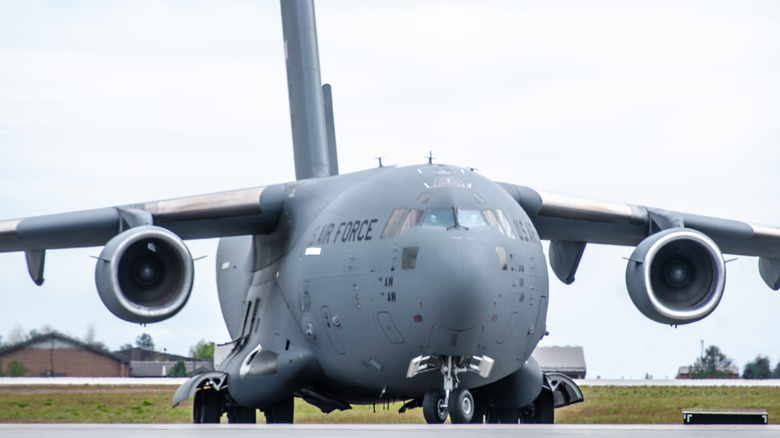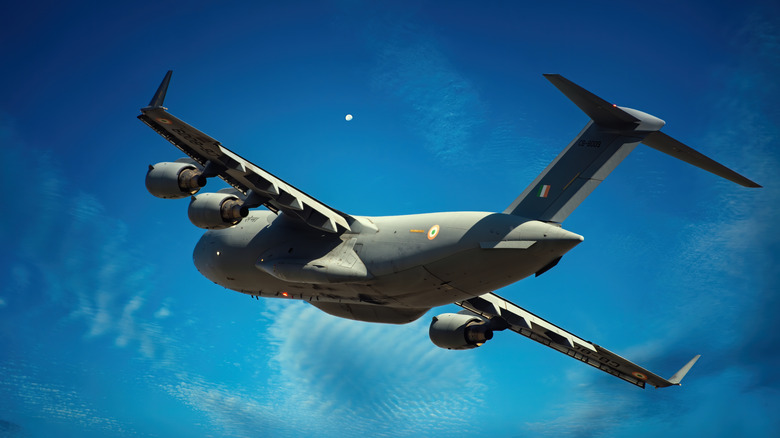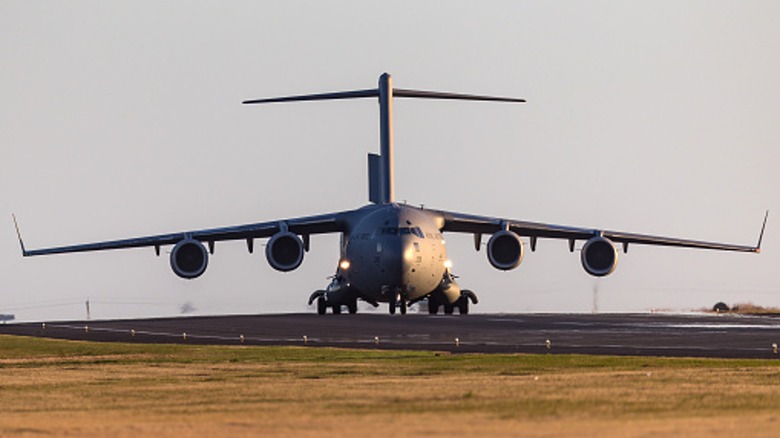Everything To Know About Boeing's C-17 Globemaster III
The first C-17 Globemaster III Boeing produced took to the air in September 1991 and the United States Air Force had first dibs, purchasing a total of 223 of them. Boeing delivered the first C-17 in June 1993 to the USAF, but the Air Force's first C-17 squadron wasn't operational until January 1995. Since then, a total of eight other countries plus the Strategic Airlift Capability (SAC) initiative purchased C-17s from the aerospace firm.
The Globemaster III is a giant cargo plane with the versatility to transport both personnel and equipment. Its cargo bay floor is designed in such a way that it can load up wheeled vehicles like tanks, or the crew can flip up built-in rollers to accommodate pallets. Additionally, it can transport troops from base to base or deploy up to 102 paratroopers into a combat zone when needed. Thanks to its high-lift wing, slats, and externally blown flaps, the C-17 doesn't require large runways to land or takeoff.
It can successfully use runways as thin as 90 feet and as short as 3,500 feet. For comparison, the typical length of a commercial runway is roughly 8,000 feet.
Let's get specific
There's no denying that the C-17 Globemaster III is a large plane. It has a diameter of 22.5 feet, is 174-feet long, and has a wingspan of 169.8-feet from winglet tip to winglet tip with an area of 3,800 sq. ft. Each of its four Pratt & Whitney F117-PW-100 turbofan engines produce 40,440 pounds of thrust and fly a maximum of 450 knots at 28,000 feet. However, its service ceiling is 45,000 feet, allowing the plane to travel 2,400 nautical miles before it requires refueling. There are positions for four flight crew members, seating two pilots and two observer positions, but the U.S. Air Force typically assigns two pilots and one loadmaster.
However, if there's a need to transport troops, the cargo bay can hold up to 54 troops on the sidewall and 48 in the centerline. A single flight transported significantly more than it could seat in August 2021, carrying 823 passengers while evacuating allied personnel from Afghanistan during Operation Allies Refuge. C-17s can be found all over the United States in service of the USAF, from March Air Reserve Base in Southern California to Joint Base McGuire-Dix-Lakehurst, New Jersey.
Training to be on a C-17 aircrew takes place at Altus AFB, Oklahoma. Naturally, America isn't Boeing's only customer using the C-17. The United Kingdom, India, United Arab Emirates, Canada, Qatar, and even Kuwait can be seen flying the C-17. Kuwait's Air Force received its first Globemaster III in 2014.
Boeing discontinued the Globemaster III
As of August 2024, 275 C-17s are in operation worldwide for a variety of nations. Despite the successful operation performance of the C-17, a lack of demand back in 2013 forced Boeing to put a halt on production of the C-17 Globemaster III. Boeing delivered the final C-17 to the United States Air Force in September 2013, giving the service a total of 223 Globemaster III's in its fleet, while the last international one wasn't delivered for another two years in November 2015 to the Qatar Emiri Air Force.
The USAF hadn't requested any additional C-17s since 2007, saying, "The military's current fleet of 223 C-17s and 111 C-5s is more than enough airlift capability for years to come." The Globemaster III is a giant of a plane, but Lockheed Martin's C-5M Super Galaxy is massive and unrivaled in capabilities, carrying a maximum payload of 281,001-lbs, versus the C-17's 170,900-lbs. The discontinuation of the plane didn't mean there wasn't any support for the Globemaster III or that it wouldn't be in use anymore.
Boeing agreed to continue critical sustainment activities, including field support and material management, for every one of the planes in use. This "follow-on" contract with the Department of Defense has a value of $23.8 billion over ten years. The planes will receive system updates through the 2028 fiscal year. Additionally, Pratt & Whitney received $55 billion in 2023 to improve the fleet's fuel efficiency with engine upgrades.


